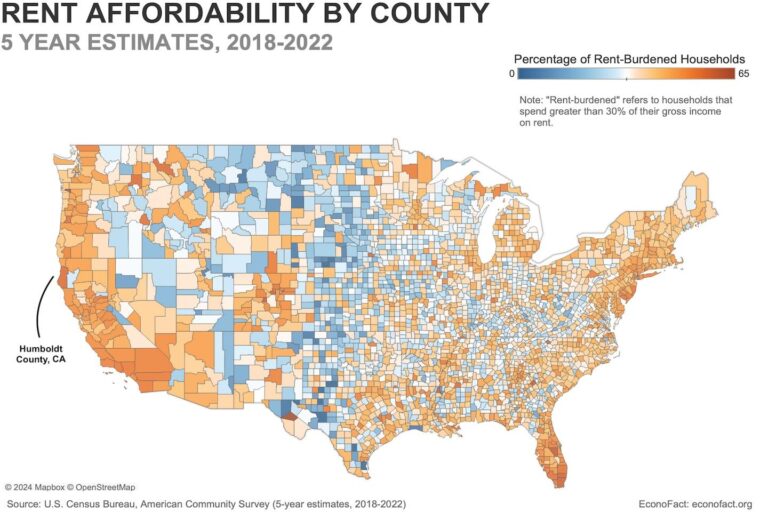As skyrocketing rental prices continue to squeeze American households, a growing number of people are abandoning traditional housing in favor of life on the move. No longer emblematic of countercultural hippies or free-spirited nomads, this emerging demographic faces unaffordable rents and limited options, pushing them into a mobile lifestyle out of necessity rather than choice. This article explores the socioeconomic forces behind the shift and examines how thousands across the United States are redefining home on wheels amid a deepening housing crisis.
The Rising Cost of Rent Drives Americans Toward a Mobile Lifestyle
As rental prices continue to soar across major metropolitan areas, a growing number of Americans are trading traditional housing for a life on the road. This emerging mobile lifestyle, driven by economic necessity rather than cultural rebellion, reflects a pragmatic adaptation to an increasingly unaffordable housing market. Many individuals and families have turned to RVs, vans, and converted buses as viable alternatives to sky-high rent, embracing mobility and minimalism out of fiscal urgency rather than choice.
Data reveals a stark shift in living situations that challenges preconceived notions about transient lifestyles. According to a recent survey, the primary motivations for going mobile include:
- Escaping exorbitant rent hikes in urban centers
- Seeking financial stability by reducing living expenses
- Flexibility in employment through remote and gig work
| City | Average Monthly Rent | Mobile Residents Increase (2020-2023) |
|---|---|---|
| San Francisco | $3,200 | 45% |
| New York | $2,900 | 38% |
| Seattle | $2,150 | 33% |
Challenges Faced by Modern Nomads Beyond the Stereotypes
Contrary to the idyllic vision of nomadism as a carefree, adventurous lifestyle, modern nomads grapple with a series of practical and often daunting obstacles. Access to stable internet remains a persistent challenge despite advances in technology; many are forced to settle for unreliable connections that impede remote work. Moreover, the constant relocation takes a toll on mental health, with feelings of isolation and disconnection from community emerging as common themes. These difficulties are compounded by regulatory uncertainties, as local laws and zoning restrictions rarely accommodate transient living, making long-term planning precarious.
Financial strain is another significant hurdle. While the mobile lifestyle appears economical at first glance, hidden costs accumulate quickly—insurance premiums for vehicles or RVs, frequent maintenance, and fluctuating fuel prices are just a few. Below is a snapshot comparison of typical monthly costs faced by a mobile nomad versus a city renter, underscoring unexpected expenditures driving this new economic reality:
| Expense | Mobile Nomad | City Renter |
|---|---|---|
| Rent or Vehicle Lease | $800 | $1,400 |
| Internet & Utilities | $120 | $150 |
| Maintenance & Repairs | $250 | $50 |
| Fuel / Transportation | $300 | $100 |
| Total | $1,470 | $1,700 |
These figures reveal that while renting a fixed residence carries heavier rent expenses, nomads face elevated costs hidden in seemingly minor, everyday necessities. The nomadic route, therefore, demands not just resilience but a nuanced budget strategy balancing freedom with financial unpredictability.
Economic and Social Impacts of Unaffordable Housing on Communities
Policy Solutions and Community Initiatives to Address Housing Insecurity
Addressing the escalating crisis of housing insecurity requires a multi-pronged approach that blends policy reform with grassroots action. Municipal governments across the US are beginning to implement rent control measures aimed at capping annual rent hikes, protecting vulnerable tenants from drastic rent surges. Additionally, zoning reforms promoting the development of affordable and mixed-income housing units have gained momentum, allowing cities to diversify their housing stock without relying solely on market forces. Federal incentives for modular housing and tiny home communities are also emerging as innovative solutions to ease the demand for traditional rental units.
Beyond legislation, community-led initiatives play a pivotal role in reshaping how housing insecurity is tackled. Cooperative housing models, where residents collectively own and manage their homes, offer a sustainable alternative to traditional renting. Neighborhood associations, nonprofits, and advocacy groups have launched mobile resource centers that provide aid and legal support to members of the “vanlife” and nomadic communities—a population often overlooked by mainstream housing policies. These initiatives emphasize self-governance, peer support, and empowerment, fostering a sense of belonging for those living on the margins of the housing market.
| Policy Initiative | Objective | Impact to Date |
|---|---|---|
| Rent Control Expansion | Limit annual rent increases | Stabilized rents for 120,000+ households |
| Zoning for Affordability | Promote multi-family and tiny homes | 20% increase in affordable units built |
| Cooperative Housing Programs | Encourage resident ownership | Empowered 5,000+ low-income families |
To Conclude
As the affordable housing crisis deepens across the United States, the rise of a mobile lifestyle among thousands is reshaping traditional notions of home and community. No longer a choice rooted in idealism or adventure, this movement is a pragmatic response to an increasingly unaffordable rental market. Policymakers and urban planners are now confronted with the urgent need to address housing affordability, or risk further entrenching a population on the move, navigating the challenges of a precarious existence on wheels. The evolving landscape demands not only immediate solutions but also a reimagining of what it means to have a place to call home in 21st-century America.







